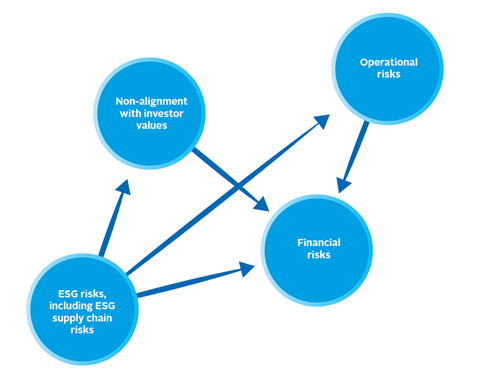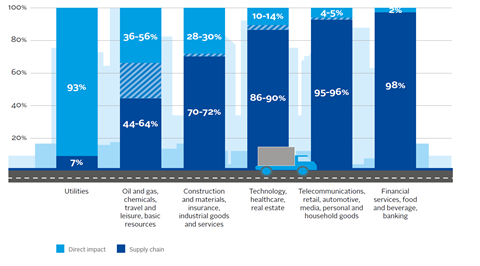Supply chains can be highly complex. They often span many countries and include multiple tiers, which are made more opaque by outsourcing and offshoring.
They are also essential to the success of almost all businesses and can be a significant source of value creation and innovation.
As supply chains fall outside of a company’s core operations, they expose them to hidden and uncontrollable risks typically driven by ESG factors, such as natural resource depletion, human rights abuses and corruption.
These issues can harm the reputations, operations and financial performance of businesses or assets owned by investors, as well as investors’ own reputations and investment performance. Compliance with local regulation is rarely sufficient to meet stakeholder expectations (e.g. certain countries in which a supplier may operate may have less robust legal and regulatory standards than others).
Material impacts from ESG risk in the supply chain
Reuters: Mattel posts lower profit on impact of recalls
Seeking Alpha: Two rotten meat and deforestation scandals threatens JBS and BRF’s IPOs
Reuters: Thai floods batter global electronics, auto supply chains
To add to the complexity of supply chains, they are heavily interdependent. As such, the relationship between products and services and ESG risk factors are intertwined across sectors and throughout every level of the supply chain.
The table below, from a study by environmental research firm Trucost, highlights the extent to which supply chains impact the environment compared to direct operations.
This report focuses on both external supply chain risks coming from third party suppliers and internal risks relating to supply chain management. The direct impacts on businesses can be felt in a number of ways:
- interruption of flow of materials, including raw materials or components;
- impact on delivery times with knock-on effects to customer satisfaction;
- poor financial management of the supplier leading to inability to supply goods on time;
- loss of social license to operate resulting from major reputational concerns linked to pollution, human rights abuses, corruption, etc.;
- increase in cost of materials as companies are forced to change their suppliers last minute.
For private market investors, managing ESG risks in the supply chain is of particular importance because:
- Private companies tend to be smaller than listed companies and so may have less stakeholder pressure to manage ESG risk in their supply chain from stakeholder pressure. They may also not have the same resources to adequately manage complex risks across multiple tiers in their supply chain.
- Private markets are relatively illiquid, so divestment to avoid reputational or other ESG-related issues may be a costly option . another reason for more detailed due diligence and engagement.
The benefits of good ESG risk management in supply chains
Managing ESG factors in supply chains brings both shortterm and long-term financial benefits:
…to operating companies or assets…
- Quicker response to emerging regulation or legal obligations which incur supply chain responsibility (e.g. UK Modern Slavery Act, modern slavery legislation in the EU, environmental laws in China, increased enforcement of labour rights in China, EU Conflict Minerals Regulation, French multinational companies Duty of Care bill, etc.).
- Protecting (social) license to operate, avoiding loss of governmental contracts (government procurement is increasingly including ESG criteria), protecting human rights, avoiding corruption, avoiding the use of child labour, managing the use of controlled materials such as conflict minerals, etc.
- Increased stakeholder confidence . including investors, clients (if investee company is a supplier), customers, communities, civil society and nongovernmental organisations, regulators, lenders, employees.
- Significant opportunity for investee company to develop long-term, trusting partnerships with their direct suppliers and to protect and/or enhance the relationship between their suppliers and their customers or end users.
- A reduction in costs through better financial risk management i.e. minimising supply chain disruption (e.g. in relation to social unrest), fines, litigation, insurance premiums, replacing suppliers, etc.
- Enhancing business continuity, contract breach, product boycotts, supplier loss, capital flight, etc.
…and to investors…
- Better alignment with internal responsible investment policies and commitments which may reference specific corporate responsibility standards.
- Alignment with internationally accepted best practices . responsibility of investors/companies as defined by the UN Global Compact, the OECD Guidelines for Multinational Enterprises and the UN Guiding Principles on Business and Human Rights.
- Higher company revenue from increased labour and process productivity . leaders in supply chain management can demonstrate a positive correlation between good management of labour rights and product quality, lead times and cost of goods sold.
- Improved environmental performance of portfolio as a whole e.g. less risk of pollution incidents, reduced environmental footprint (e.g. carbon, water, ecological), and increased efficiencies resulting in financial value creation opportunities.
- Formal supply chain management procedures can make investee companies and assets more attractive as investors look to exit.
ESG factors in supply chains: rising up the investor agenda
Businesses are increasingly expected to understand and manage their exposure to supply chain risks. Public awareness of supply chain issues continues to grow, with globally renowned companies increasingly under scrutiny to take action on major ESG issues among their suppliers. Rapid advances in technology are making it easier and less costly to monitor supply chains. For example, blockchain and virtual reality (VR) technology could make it far simpler for large organisations to virtually visit their sites and trace upstream suppliers on the other side of the globe. In many sectors, risks are often far greater in the supply chain than in the investee company’s direct operations. For those with a good understanding of their supply chain, this is a great opportunity. For others, it is getting harder to hide.
Companies are increasingly expected to understand and manage their exposure to supply chain risks. For those with a good understanding of their supply chain, this is a great opportunity. For others, it is getting harder to hide.
The implications extend to investors. The OECD’s paper, Responsible Business Conduct for Institutional Investors, clarifies expectations of responsible business conduct for institutional investors under the OECD Guidelines for Multinational Enterprises. It states that the relationship between an investor and an investee company is different from the relationship between purchaser and supplier companies, but that the investor can seek to influence the responsible business conduct of the investee company through ownership. Even minority shareholders may be directly linked to adverse environmental and social impacts caused or contributed to by investee companies in their portfolios.
As a result, investors are expected to undertake ESG2 risk-based due diligence and consider ESG risks in their investment processes. For LPs, this starts with including ESG risk in due diligence on the GP before making a commitment to the fund and including these risks in ongoing monitoring of the GP. For GPs and direct investors, this requires identifying ESG risks before the investment and monitoring them during the holding period. Investors are then expected to use their leverage with companies to influence them to prevent or mitigate adverse impacts.
Companies face significant commercial and physical challenges to managing risks throughout their supply chains, especially when they have multiple tiers. Investors rarely systematically or explicitly articulate their expectations for how investee companies should manage ESG risks and opportunities in their supply chains. Many companies are just beginning to develop the tools and practices needed to identify, engage with and manage these issues. Even best practice ESG risk management is generally limited to the operations of the investee company itself and does not encompass the multiple supply chain tiers on which it depends.
In seeking to manage risk within their portfolios, investors have an opportunity to help drive ESG factors in supply chain up the corporate agenda.
What to look out for
Given the implications of ESG issues arising in investee company supply chains, there are clear incentives for investors to engage those companies and manage the risks more effectively. Investors should ensure investee companies are:
- applying due diligence when identifying and managing ESG risks and opportunities with their direct suppliers of goods and services; and
- liaising with their direct suppliers to engage with their own direct goods and services suppliers (i.e. second tier suppliers to the investee companies), effectively creating a cascade of ESG management through the supply chain.
Landing on ‘not enough information to assess’ is an insufficient due diligence conclusion. The conclusion should be that significant ESG risks may exist and that the deal team will assess in more depth immediately post-acquisition
Adam Heltzer, Partners Group
Downloads
Managing ESG risk in supply chains
PDF, Size 0.64 mb
Managing ESG risk in the supply chains of private companies and assets
- 1
Currently reading
Why ESG factors in the supply chain matter
- 2
- 3
- 4
- 5
- 6
- 7
- 8




















